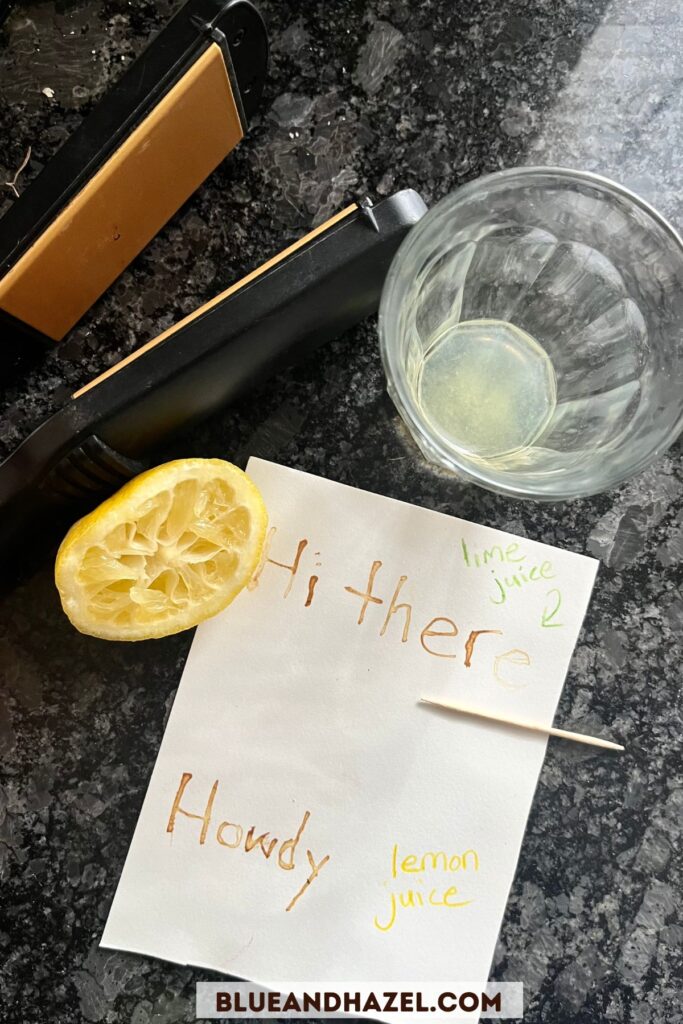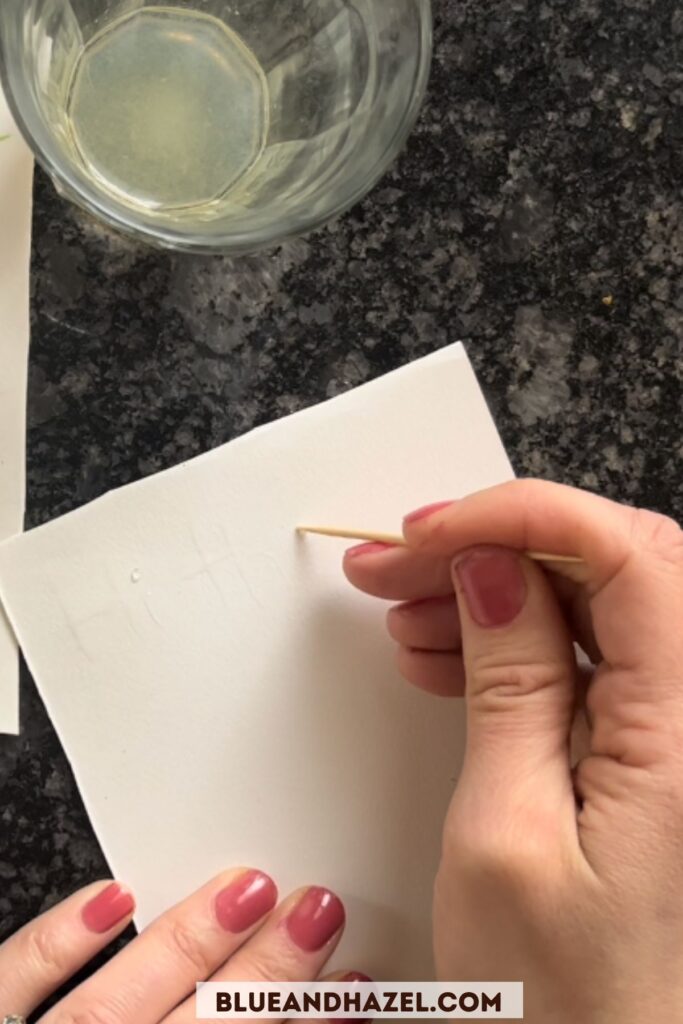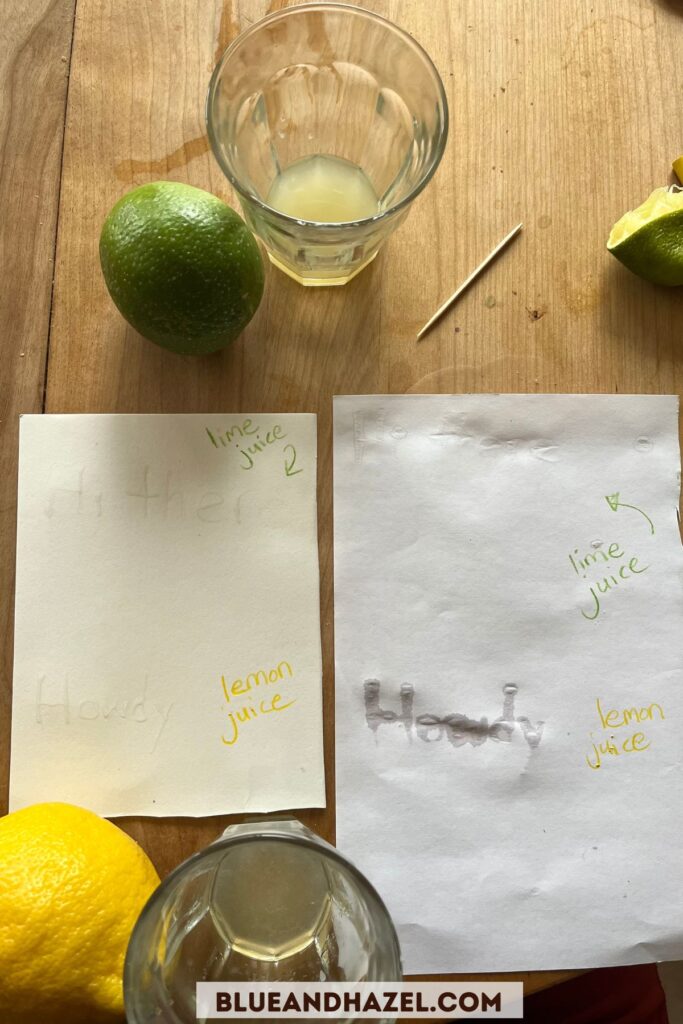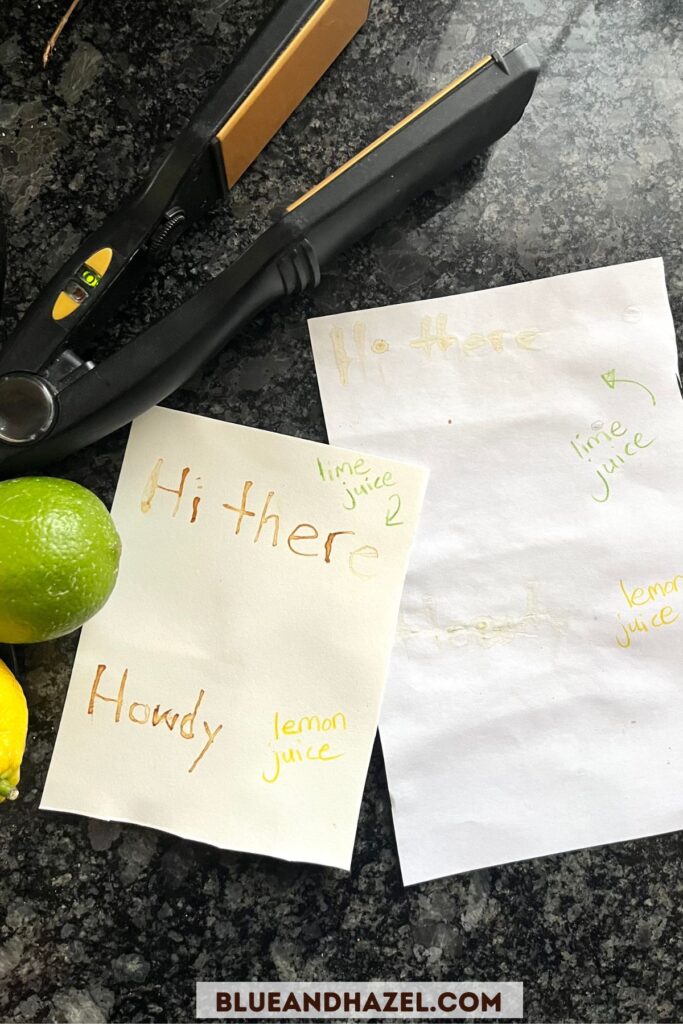The first time I learned how to make invisible ink with lemon juice (lime juice works too), I wasn’t sure it would work. Good news…it actually does! This was such a fun thing to do as part of our 2nd and 3rd grade homeschool curriculum. The “ink” made from lemon juice dries clear on paper, and when hot heat is applied to the paper the lemon juice letters appear!
You can also watch my YouTube video on how to make invisible ink.
Be sure to check out my homeschool resource page for more homeschool posts organized by subject and year!
What to make with invisible ink
You can write your kids a silly message to uncover, or make a scavenger hunt where they have to heat up each clue before moving on. This would be a fun thing to add on to these easy beginner writing ideas for 7 and 8 year olds.
Have kids send friends a short invisible note in the mail (with instructions to heat it up), or write a coded message in invisible ink.
You could draw a map with pencil but add any “secrets” to the map in invisible ink (like an x that marks the treasure). The ideas are endless! Here’s a look at how easy it is to make.

Supplies needed to make an invisible ink message
- watercolor paper (nice and thick and won’t easily rip, wrinkle, or oversaturate with lemon juice)
- lemon juice from 1/2 a lemon (add 1/2 teaspoon of water for extra clear letters when dry)
- an iron ( a clothes iron or hair straightener)
- toothpick, chopstick, paintbrush, or Q-tip for dipping and writing
How to make invisible ink with lemon juice and heat
Step 1: Squeeze lemon juice
Squeeze half a lemon into a shallow dish or small cup. This is your “ink”. Lime juice works equally as well if you only have limes at home.
Tip: Add a few drops of water and mix together to dilute for an extra secret message. While lemon use dries mostly clear, the small amount of water helps it to be more invisible when dry while still browning with heat.
Step 2: Write
Dip a toothpick, chopstick, or Q-tip into the lemon juice and begin to write on the watercolor paper. If you use a toothpick, be sure to get enough lemon juice onto the paper for each letter or it won’t show up well when heated.

Step 3: Dry
Let the lemon juice dry on the paper. This takes around 5-10 minutes.

Step 4: Apply heat
Using a hot iron (in my case a hair straightening iron), press the iron onto the paper for about 10 seconds. You can experiment with how long is ideal to apply heat to get your ink to turn brown.
If you find the letters aren’t getting as dark they should, apply heat for a few more seconds and check. My first time revealing invisible ink I only applied heat for about 5 seconds and it only turned a light blonde color. So I put the iron back on for more time until it all turned a nice, caramel brown.

Hint: Areas with more “ink” will be darker brown than areas where less was applied. Also, thick watercolor paper worked SO much better than thin 20lb printer paper. See below.
I think the thin printer paper was not able to press against the flat iron to heat up enough, where as the thick watercolor paper easily touched the hair straightening iron when squeezed.

Why does lemon juice turn brown when heated?
Lemon and lime juice are organic substances (in chemistry that means it contains carbon). These turn brown when heated because the carbon is released into the air and then oxidizes.
It’s similar to how a sliced apple oxidizes once it is exposed to the air.
Why does lemon juice dry invisible?
Lemon juice is made up of water, sugar, and citric acid. These are all fairly colorless when dry! The citric acid inhibits oxidation that would turn it brown, which is why heat is needed. Heat breaks down the citric acid and exposes the lemon juice to oxidation.
Using apples and lemon juice to further explain oxidation
If you want to realllly draw this out as a science experiment, cut up an apple into thin slices. Put half into a bowl tossed with lemon juice, and half the slices in a bowl without anything. Let sit for a while until one bowl starts to brown.
Which one turns brown? (The bowl without any lemon juice). Why?
The citric acid in the lemon juice coats the apple, keeping it from oxidizing and turning brown when touched by the air.
What if I can still see the invisible ink on paper when it dries?
I found mine very hard to see with 100% lemon juice used, but if you want it to be even more discreet you can dilute the lemon juice with a few drops of water. (about half a teaspoon per half a lemon)
This will help it to dry even more invisible.
Science experiment opportunity: Try one with full lemon juice and one diluted with water. What do you notice when dried? When heated?
See how invisible ink was used in the US Revolutionary War!
I think it’s so awesome that letters were coded, sent in pieces, and several invisible inks were known to be used to send messages to protect them from being intercepted by the enemy! Read more about how they sent secret letters in the Revolutionary War here.
More homeschool posts
- MEGA list of free nature curriculum and resources for all 50 US states
- Why we love Exploring Nature With Children curriculum
- How we organize one year of curriculum by weeks using the crate system
- Best economical color printer for homeschooling
- What is deschooling?
- Dealing with homeschool burnout
- How to teach kids to count money
- Homeschooling exhaustion while pregnant
Save and share
If you enjoyed this, please Pin it for later or share it on socials! I hope you’ll try this and have fun doing so!